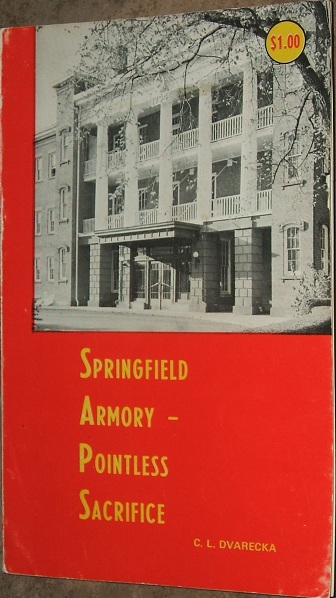 This When I came across this copy of Christopher L. Dvarecka’s Springfield Armory – Pointless Sacrifice, I was hoping for an interesting behind-the-scenes view of the operations of Springfield. Unfortunately, I quickly became dubious after reading the rear cover – where it describes the Armory as “forsaken by its ‘friends'” and “doomed because of its very excellence.” Not exactly the objective view I was hoping for, but you never know until you actually start reading.
This When I came across this copy of Christopher L. Dvarecka’s Springfield Armory – Pointless Sacrifice, I was hoping for an interesting behind-the-scenes view of the operations of Springfield. Unfortunately, I quickly became dubious after reading the rear cover – where it describes the Armory as “forsaken by its ‘friends'” and “doomed because of its very excellence.” Not exactly the objective view I was hoping for, but you never know until you actually start reading.
As a quick bit of background for folks who may not be aware, Springfield Armory was the US’ oldest Armory, having been established at Springfield Massachusetts in 1794 (and been an Army powder magazine since 1777). It was responsible for manufacturing small arms for the US military, as well as aiding commercial contractors in production of the same. Through the 1800s, the Armory was a major part of American industrial development, and many of the country’s noted arms makers spent time in its employ before moving on to private endeavors. The Armory also conducted small arms R&D, it is was within its walls that rifles like the M1 Garand were developed. This all ended in 1968, though, when it was shut down in an effort to reduce costs, and most of its functions relocated to Rock Island Arsenal in Illinois (this shutdown is what the book’s title references). The Springfield Armory Inc selling guns today licensed the name in 1974, and has no other connection to the government Armory (including location, as the company is based in Geneseo, IL).
Anyway, back to the book. It was published in 1968 as the Armory was in the final stages of being shut down (a staged process that had begun in 1964), and it is a basic history of the Armory and a lament of its fate. The author, Colonel Dvarecka, was Historical Officer for the Armory and director of its museum from 1954 until 1968, and his anguish at its closing is certainly understandable (and I would have jumped at the chance to talk about the Armory’s history with him, but he passed away in 1993). However, it does seriously limit the book’s objectivity – closing Springfield may have been a terrible idea, but Dvarecka portrays it as a flawless example of everything America stands for. In reality, we know that there was plenty of strife, inefficiency, and flat-out bungling within its bureaucratic walls.
Think of Springfield Armory – Pointless Sacrifice as an extended obituary for the institution, which truly was an American icon. The first three quarters of its pages describe the history of the Armory, free of political subjectivity. For folks interested in the history of manufacturing, it makes a pretty good read, as the facilities transition from colonial workshop (complete with racks for the craftsmens’ jugs of rum) to a factory of the Industrial Revolution to a modern prototyping man fabricating facility. Over the decades it fluctuated between periods of inactivity (including nearly being shut down in 1878) and those of frenzied production (like the Civil War and both World Wars), slowly expanding and modernizing.
The work is long out of print, but can still be found on Amazon used. The price is right at the top end of what I would consider reasonable, primarily for people with an interest in manufacturing – it does not describe the specific guns made at the Armory in much depth at all. If you can find it for a couple bucks at a gun show, though, it is definitely worth getting to add that bit of niche information to your library. For those who don’t want to wait for that possibility, here is the Amazon link:



Farewell Springfield. Nothing but contractors now.
So David…I feel some neg. feeling in your statement? As if “contractors” was a dirty word? If you have a minute would you explain…if I have mis-understood..my mistake. But I own an XDM which has served me well in competitions and I am very happy with it how it runs under stress. What am I missing here???
You’re missing the fact that the HS2000 sold for less than $300 before “Springfield Armory”, Inc. put their pretentious name on the slide.
Even without deeper knowledge of relevant background, one is prone to think that the same pattern of ‘governmet ineffieciency’ applies here too. Let’s just consider the fact that at the time of its closing another, private company was high on the swing making M16s, whose design was initiated by another private company. Bureaucracy kills initiative.
If you think bureaucracy is limited to government you haven’t worked in any organization with more than 10 people 😉
What you probably mean is ‘hierarchy’; have seen plenty of it thru the years. It also depends on culture and individual perceptions as how it projects into internal relations. I can also tell you about that…. But that may not much to do with Springfield’s fate.
Ludwig von Mises puts it far more eloquently than I can:
“In the interventionist state, every business is under the necessity of accommodating itself to the wishes of the authorities in order to avoid burdensome penalties.
The result is that these and other considerations foreign to the profit-seeking principle of entrepreneurial management come to play an ever increasing role in the conduct of business, while the part played by precise calculation and cost accounting concomitantly dwindles in significance, and private enterprise begins increasingly to adopt the mode of management of public enterprises, with their elaborate apparatus of formally prescribed rules and regulations. In a word, it becomes bureaucratized.
Thus, the progressing bureaucratization of big business is by no means the result of an inexorable tendency inherent in the development of the capitalist economy. It is nothing but the necessary consequence of adopting a policy of interventionism. In the absence of government interference with their operations, even the largest firms could be run in exactly as businesslike a way as the small ones.”
Excerpted from Ludwig von Mises; “Liberalism” 1927
von Mises uses the word “Liberalism” in its original, small government, laissez faire, classical sense; opposite to the current American import of the word.
A fuller excerpt is available here http://mises.org/daily/5998/Bureaucratization and the full text of “Liberalism” is also available as free .pdf and ebook on the mises.org site
Hello from a contractor. I tend to agree with Denny that bureaucracy hurts initiative in this field having seen it often but, with 27 firearm patents, formulas & designs to my name I can also say it doesn’t stop it. The adoption of and rejection of various designs and upgrades in this field would hurt your feelings as politics and sporadic funding play way to big of a role. The book review here of “The Great Rifle Controversy” made me laugh. Thanks for the recommended read. The problems identified in that book is still alive and well.
The problems experienced by / with the Springfield Armory are common to any government activity.
They stem from “The Calculation Problem” and “The Knowledge Problem”
Both were first formalised by von Mises and “The Knowledge Problem” was further elaborated by Mises’ one time research assistant, Frederic Hayek, notably in his 1945 essay, “The use of knowledge in society”
Put as simply as I can;
a government can obtain money, goods, services etc by force, it can tax, it can print extra paper money.
Private individuals must provide goods or services which other people desire, in order to exchange them for the goods services or money they desire from others.
The relative exchange rates between any goods or services or money, reflect people’s desire for them, and their availability – the prices serve as a mechanism to communicate what people want.
using price, we can work out whether what we are doing is efficeintly turning things which people value less, into things people value more – if we are doing it efficeintly, we make a profit, if we are doing it inefficeintly – if we are turning something more valued into something less valued – we make a loss, and soon have to stop.
a government is a monopoly, there is no competitor doing things better, and it can get its money by tax or by printing more – it has no way to know what people actually value more or what people value less – only who shouts the loudest.
It therefore has no way of knowing what it should be doing or making, and no way to calculate if it is doing it efficeintly or inefficeintly.
Very well put Keith. Ultimately, what remains to be said is that the pretense of representative democracy (and its reflection to function of goverment) remains just that – a pretense. It should be well known that it is not a “new” problem but the one, which is deeply entrenched as we can see from numerous examples.
On my part, I cannot resist to pitch in my final though. Thank you!
Gents,
Springfield Armory’s buildings still stand overlooking the Connecticut River in the decaying mill town of that name. They’re rather underutilized, but along with a very low-end community college they host an excellent museum as part of the National Historic Site.
While memorializing the Armory, people tend to remember the best of its products, the M1903 (which was actually a Mauser clone, with, if I understand correctly, a license royalty paid only after getting caught) and M1 Garand (which might be the one true innovation produced there — everybody including Stoner and Kalashnikov copied the trigger mechanism, although it wouldn’t shock me to learn Garand himself had lifted it from somewhere). A lot of Springfield’s production were also-rans (the Krag?), merely at par with the stodgiest foreign inventions (the Trapdoor) or complete knock-offs (put any of the early Springfield muskets next to a Charleville).
And a lot of Springfield’s R&D was out in Wolkenkuckückheim (cloud cuckoo land). The SPIW and flechette weapons were never practical at all.
So, yes, celebrate the history (and don’t miss the museum, it’s one of America’s best) but don’t romanticize the history. Has any organization ever been a technology leader for 100 years?
The double hooks of the M1 rifle’s lockwork is lifted from Browning’s Remington Model 8 and Model 11. Early Model 11 also had a sliding safety inside the trigger guard just ahead of the trigger.
At least Springfield is a museum. The Watertown Arsenal, where some of America’s greatest artillery was developed and built, is a shopping mall.